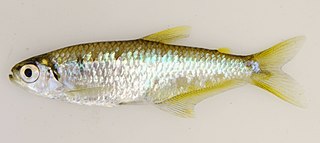
Characidae, the characids or characins is a family of freshwater subtropical and tropical fish, belonging to the order Characiformes. The name "characins" is the historical one, but scientists today tend to prefer "characids" to reflect their status as a by and large monophyletic group at family rank. To arrive there, this family has undergone much systematic and taxonomic change. Among those fishes that remain in the Characidae for the time being are the tetras, comprising the very similar genera Hemigrammus and Hyphessobrycon, as well as a few related forms such as the cave and neon tetras. Fish of this family are important as food and also include popular aquarium fish species.
Mimagoniates is a genus of characid fish from rivers and streams in southeastern, southern and central-western Brazil, northeastern Argentina, and Paraguay. The individual species generally have relatively small ranges and two, M. lateralis and M. sylvicola, are considered threatened by Brazil's Ministry of the Environment.
Attonitus is a genus of characin endemic to Peru.
Bryconacidnus is a genus of characins found in tropical South America.
Chrysobrycon is a genus of characins endemic to South America.

Creagrutus is a genus of characins found mostly in South America, with one species C. affinis extending into Panama in Central America.

Diapoma is a genus of characins from tropical South America.

Gephyrocharax is a genus of characins found in South America, Trinidad in the Caribbean, and Panama.
Glandulocauda is a genus of small characin freshwater fish that are endemic to Brazil, where restricted to the upper Paraná basin and coastal river basins in São Paulo state. The genus it is closely related to Lophiobrycon and Mimagoniates, and they form the tribe Glandulocaudini.

Hemibrycon is a genus of characins. They are mainly found in South America, Trinidad in the Caribbean), and H. dariensis of east Panama.
Hysteronotus megalostomus is a species of characin endemic to Brazil where it is found in the upper São Francisco River basin. This species is the only member of the genus Hysteronotus.
Knodus is a genus of characins, small freshwater fish from South America.
Landonia latidens is a species of characin endemic to Ecuador, where it occurs in the Vinces River. This species is the only species in the genus Landonia.
Lepidocharax is a genus of characins endemic to the Doce, Paraguaçu and São Francisco basins in eastern Brazil. They are small fish, that reach up to 4 cm (1.6 in) in standard length.
Lophiobrycon weitzmani is a species of small characin endemic to Brazil, where it is found in the upper Paraná River basin. It is considered threatened by Brazil's Ministry of the Environment. This species is the only member of the genus Lophiobrycon, but it is closely related to Glandulocauda and Mimagoniates.
Planaltina is a genus of characins endemic to Brazil.
Rhinobrycon negrensis is a species of characin endemic to Brazil. This species is the only member of the genus Rhinobrycon.
Rhinopetitia is a genus of characins endemic to Brazil.
Trochilocharax ornatus is a species of characin endemic to Peru. This species is the only member of the genus Trochilocharax.
Tyttocharax is a genus of characins found in tropical South America.




